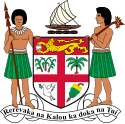2018 Fijian general election
Appearance
| |||||||||||||||||||||
All 51 seats to the Parliament of Fiji | |||||||||||||||||||||
|---|---|---|---|---|---|---|---|---|---|---|---|---|---|---|---|---|---|---|---|---|---|
| |||||||||||||||||||||
| |||||||||||||||||||||
 |
|---|
General elections will be held in Fiji on 14 November 2018.[1]
Background
On 30 September Prime Minister Frank Bainimarama announced that the elections would be held on 14 November 2018. President Jioji Konrote subsequently dissolved parliament in accordance with section 58(3) of the constitution, on the advice of the Prime Minister.
Election schedule
Key dates relating to the general election will be as follows:
| 30 September (Sunday) | Prime Minister Frank Bainimarama announces elections to be held on 14 November 2018. |
| 30 September (Sunday) | President Jioji Konrote dissolves parliament in accordance with section 58(3) of the constitution, on the advice of the Prime Minister. |
| 1 October (Monday) | President Jioji Konrote issues the writ of election |
| 1 October (Monday) | Registration of voters will end at 6 p.m. |
| 2 October (Tuesday) | Candidate nominations open at 8 a.m. |
| 15 October (Monday) | Candidate nominations close at 12 p.m. |
| 24 October (Wednesday) | Postal voting applications close at 5 p.m. |
| 5 November (Monday) | Early voting begins |
| 10 November (Saturday) | Early voting ends |
| 12 November (Monday) | Media blackout on campaigning commences at 7.30 a.m. |
| 14 November (Wednesday) | Election Day – polling places open from 7.30 a.m. to 6 p.m. |
| 14 November (Wednesday) | Election Night – provisional results will be progressively released from 6 p.m. |
Electoral system
The 51 members of the Parliament of Fiji are elected from a single nationwide constituency by open list proportional representation with an electoral threshold of 5%. Seats are allocated using the d'Hondt method.[2][3]
References
- ^ FEO Launches 2018 General Elections Publication Handbook Fiji Sun, 19 January 2018
- ^ Electoral system IPU
- ^ Electoral system for national legislature – Fiji IDEA


